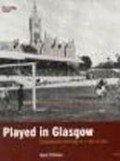|
As revealed in this very column last month this book has now hit the streets and covers the great sporting heritage of Glasgow-- a heritage that the clubs of Anniesland have contributed to in no small measure
Within its pages it charts the famous venues and landmarks from Hampden, Ibrox ,Parkhead all the way to the Old Anniesland stand and the New Anniesland scoreboard!
THE HERALD REVIEWS
Doug Gillon on Wednesday – A new book reminds us of the importance of protecting our sporting legacy
Doug Gillon, 13 Apr 2010 23.16
Glasgow aspires to develop a significant legacy around the 2014 Commonwealth Games.
But how robustly has it protected its legacy from the past?
The city’s three major football grounds were the largest in the world as the twentieth century dawned. The first specialist football stadium engineer was a Scot.
Given that Parkhead (opened 1892) will host the 2014 opening ceremony; Ibrox (1899) is the rugby sevens venue; Hampden (1903) is to stage athletics; that the Kelvin Hall (rebuilt in 1927 after a fire) will house boxing; and the adjacent Kelvingrove Park will host bowling 109 years after the first greens were laid there, suggests the legacy of that era has endured.
Yet a newly-published book, Played in Glasgow, documents a remarkable breadth and depth to Glasgow’s sporting heritage. This ranges from the first rugby cap presented (1871) and arguably the oldest private baths club (founded the same year) to doocots which still stand, and croquet lawns for sedate ladies which evoke memories of Little Women … Glasgow Celtic Society on College Green … regattas on the Clyde … Dr Alister McKenzie’s redesigning of Pollok golf club (for a fee of £40) before going on to plan Augusta National.
If sport without a history is sport without a soul, O’Brien has struck a blow for preserving that soul.
O’Brien puts it all in perspective, presenting a new insight, but also demonstrating that parts of a rich historic tapestry are being shredded and unravelled. Tennis and bowling clubs gone in Pollokshields, swimming pools and curling facilities under threat. Though it concedes the impact of restoration projects on some baths, golf courses and boathouses.
O’Brien is a teacher, football historian, and museum curator. He was project director, helping to establish the Scottish Football Museum at Hampden. Now, he has charted the depth and scope of Glasgow’s influence on sport. Given his football roots, this book might easily have simply been a grovelling paean to the beautiful game. Even if the cover does show a 1901 football match played in a temporary stadium and cycle track in the shadow of Glasgow University, it does so in the context of history under threat of being lost.
If sport without a history is sport without a soul, as I believe, then O’Brien has struck a blow for preserving the soul of sport.
On its back, I believe there is a case for introducing plaques, akin to the Wedgewood blue ones adopted by English Heritage, used to identify the homes of the famous and perhaps buildings of significance.
If we are to project Glasgow as a sporting city, honour its heritage, then the city council, or an appropriate charitable trust, might care to consider plaques around significant sites. There is much worthy of commemorating ahead of 2014.
How about a plaque to mark the Govan home of Andrew Watson, Britain’s first black footballer, for example? For years England have claimed that honour for Arthur Wharton of Preston North End. Several websites I consulted yesterday still do so. Yet Queen’s Park’s Watson pre-dates him by 11 years. He was capped three times by Scotland, and also played in the FA Cup, thus also the first black player in that tournament. Born in Guyana, Watson’s Scottish father was a sugar planter. His son came to Glasgow and first appears in the records with Maxwell FC in 1874. He played 36 times for the Spiders. He eventually immigrated to Australia.
Played in Glasgow is a good starting point for correcting history, for reminding that the modern form of football has its roots in Scotland. That water polo and the modern laws of bowls were devised here. More plaques? Why not?
Perhaps another at the House for an Art Lover, where ladies played croquet?Just a porch survives.
And another on Buchanan Street, where Miss Cranston’s tea rooms had a Rennie Mackintosh billiard table and games room, for which the architect designed all the fittings. There’s a photograph of distinctive Mackintosh snooker equipment, including a magnificent table, none of which is known to have survived decommissioning between the wars.
Mackintosh’s father, incidentally, helped establish the Glasgow Police Athletic and Rowing Club in 1882.
There are other relevant aspects of heritage. Like the Cross Arthurlie Quoiting Club – a plaque in Barr-head, perhaps, to mark what was once one of the country’s most popular games. Hurling a heavy quoit (pronounced kite) was first mentioned in 1361 (a ban issued by Edward III). I recall covering a match in Renton in the 1980s. Only three clubs now survive in Scotland.
If you’ve suggestions as to famous Glasgow sons or daughters, or historic sport venues perhaps worthy of a plaque, email us at [email protected]
Played in Glasgow (Malavan Media, £14.95) by Ged O’Brien.
This article was originally posted on 14-Apr-2010, 07:00 by Hugh Barrow.
Last updated by Hugh Barrow on 14-Apr-2010, 07:14.
|









